brakes VOLKSWAGEN GOLF PLUS 2012 Owners Manual
[x] Cancel search | Manufacturer: VOLKSWAGEN, Model Year: 2012, Model line: GOLF PLUS, Model: VOLKSWAGEN GOLF PLUS 2012Pages: 541, PDF Size: 98.86 MB
Page 31 of 541
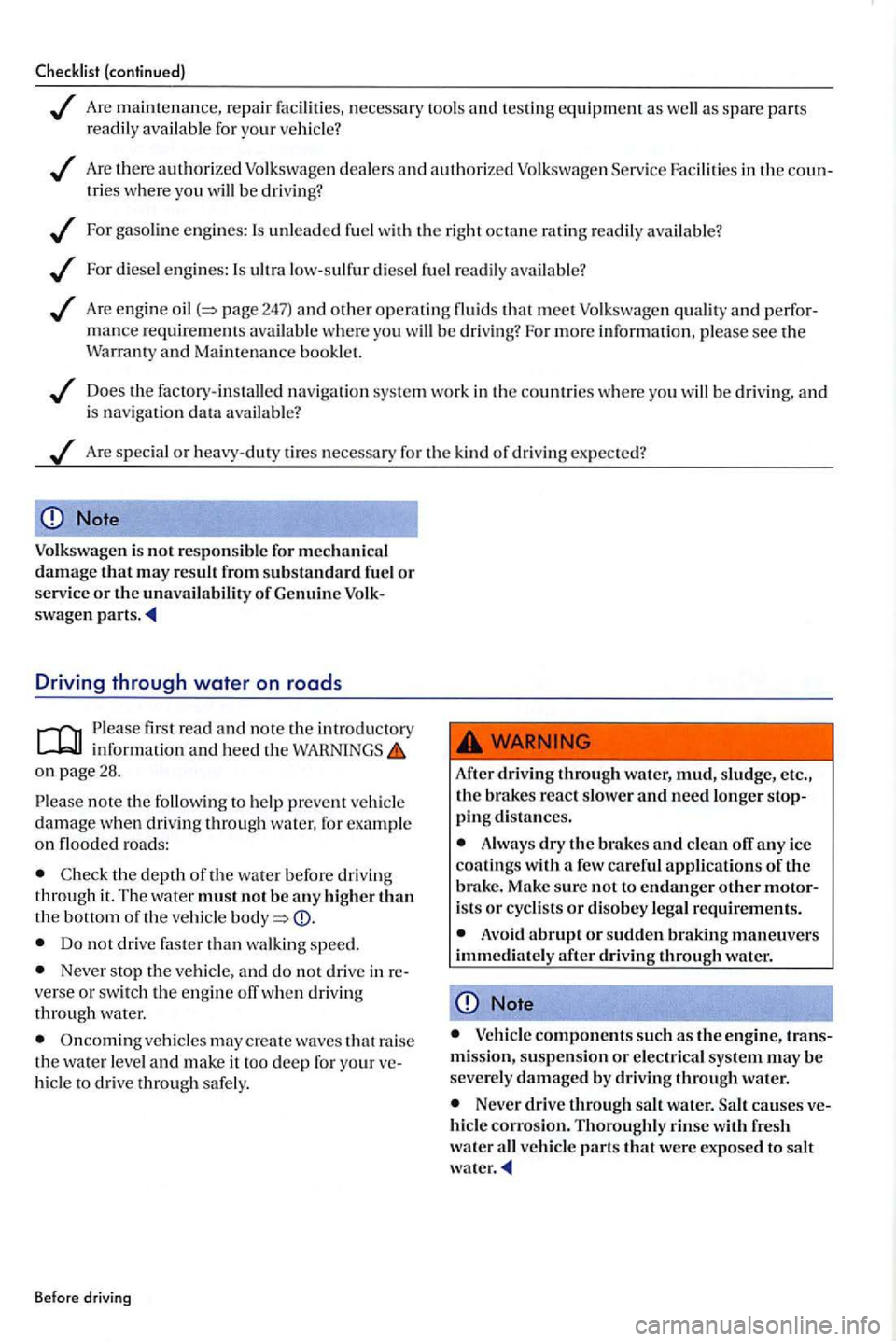
Are maintenance , repair facilitie s, necessary tools and t es tin g equipmen t as for your
Are th ere authorized Volkswagen dea le rs a nd authorized Volkswage n Fac ilities in the coun-trie s where you be driving?
For unleaded with the right octane ratin g readil y
For di es el eng ines: low-s ulfur diesel
Are engin e that meet Volkswagen and p erfo rmance requirements be dri ving"? F o r more inf ormatio n, please see the War ranty and Mai ntenance bookl et.
Does the factory- install ed nav igation system wor k in the co untries w here yo u be dri ving , and is nav igat io n data
Are sp ec ial or heavy-duty tires necessary for the kind of driv in g expec te d?
Note
Volk swagen is not responsible for mechanical damage that may re sult from substandard or service or the unavailability of Genuine Volk
swagen parts.
first read and note introd uctory informatio n and heed th e on page28.
note the following to preve nt damage when driving through wa ter, fo r examp le
o n roads :
Check depth of th e w ater before driving throu gh it. Th e wa te r must not b e any hi gher than th e bottom or the
Do no t dri ve faster than walkin g sp eed .
Never stop the a nd do n ot driv e in re
verse or swit ch the engine off when driving
through water.
Oncoming may create waves that raise the water to drive through safe ly .
Befo re driving
After driving through water, mud, sludge, etc., the brakes react slower and need longer stopping di stances.
A lw ays dry the brakes and
Avoid abrupt or sudden braking maneuvers after water.
co mponents such as the engine, transmission , suspension or electrical system may be sev erely damaged by driving through water.
Never drive through salt water.
parts that were exposed to salt water.
Page 154 of 541
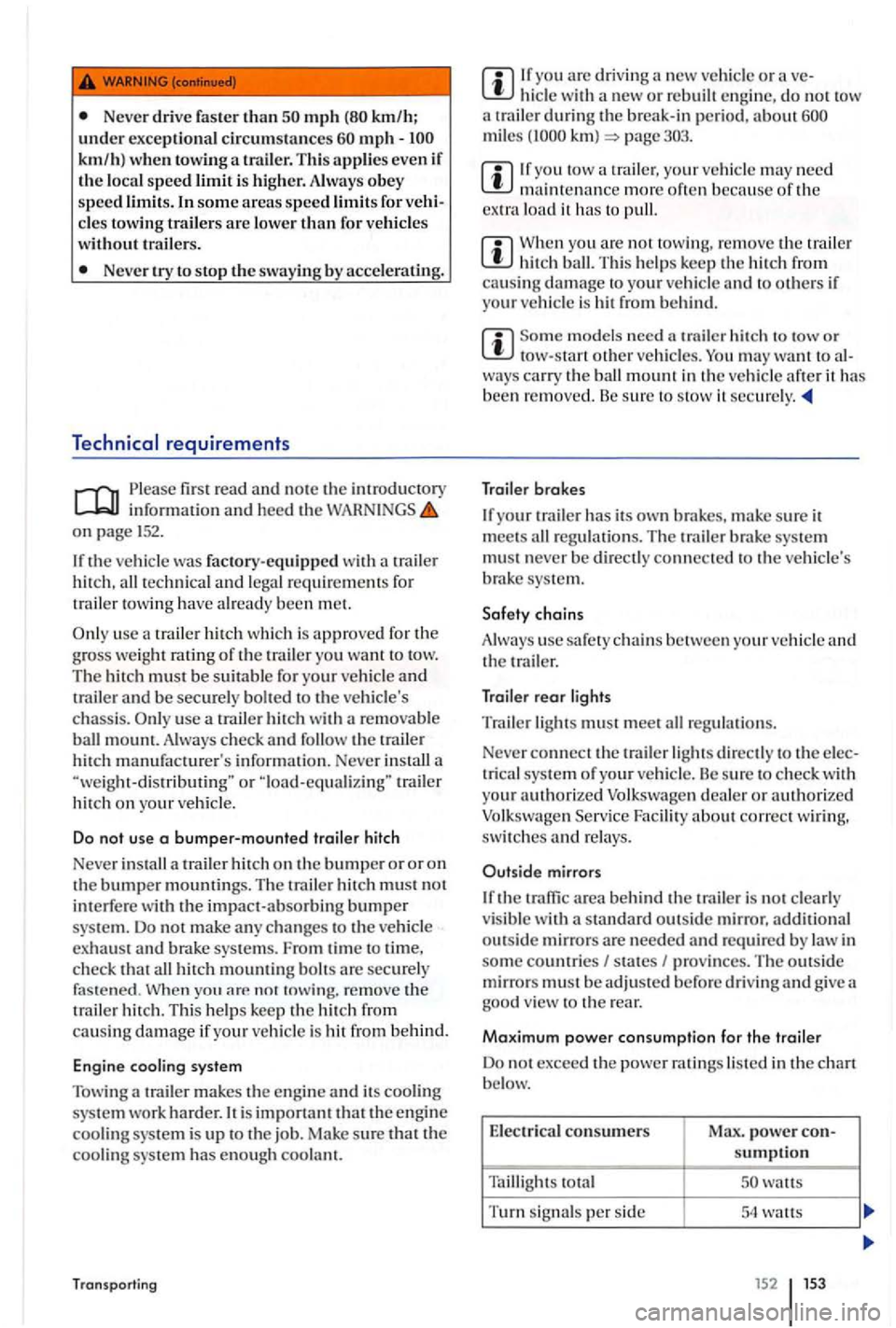
Never drive fa ster than mph mph -
Never try to stop the swaying by accelerating.
fir st read a nd note the imroductory informatio n and heed the on page
If the ve hicle was fac tory-equipped with a trail er
hi tch, all technical and lega l require m em s fo r
trailer towi ng have already been m et.
use a trai le r hitc h w hich is approve d for the
g ro ss wei ght rating of the trailer yo u want to tow. The hit ch mus t be s uitabl e fo r your vehicle and
tr ailer and be securely bolt ed to the ve hicle's chassis. use a trail er hitc h with a re movable ball mount. Alway s check and follow the trail er
hi tch manufacturer's information. Neve r in stall a o r tra ile r hitch on yo u r vehicle.
D o n
ot use a bumper-mounted trai le r h itch
Never insta
ll a trailer hitch on the bumper o r or on th e bumper mountings. The traile r hit ch mus t not in terfe re wit h the impact-absorbing bumper syste m . D o not make any changes to the ve hicl e exhaust and brake sys te m s. From time to time, check that all hitch m oumin g bolts are securely fas ten ed . W hen not towing. re m ove the trailer hi tch. Thi s help s ke ep the hitch from causin g damage if your ve hicl e is hit from behind.
Eng ine cooling syste m
Tow ing a tra
iler makes the e ngin e
If you arc dri ving a new ve hicle or ave-do not tow
a t railer
mil es
need
load it h as to pull.
When you are not towin g, remove the trailer
models need trail er hit ch to tow or tow -s tart other ve hicl es. may
Trailer brakes
If your trail er has its own brake s, make sure it
meet s all regulati ons. Th e trailer bmke sys te m
mu st never be directly connecte d to the ve hicle's brake system .
Safety c
hain s
A lways u
se safety chains be tween yo ur vehicle and
th e trailer.
Trail er rear lights
Tra
ile r lights must meet all regulation s.
Neve r
connect the tmil er l ights directly to the e lec
trica l s ys tem of your ve hicl e. Be su re to check wit h
your authorized Volkswagen dealer or authorized Volk swagen Faci lit y about correct w iring, sw itches and re lay s.
Outside mirrors
I f
the s ta ndard ou ts id e mirror, addition al outs ide m irrors are needed and required b y law in so me coumrie s I states I provin ces. The o uts id e
mirr o rs mus t b e adjuste d b efore driv in g and g ive good v iew to the rear.
Max im um power consump tio n f or th e trailer
D o no t excee d the power ratin gs liste d in the chart below.
E l
ectrical consumers power con-sumptio n
Taillight s
Turn signals pe r sid e 54 wat ts
Page 180 of 541
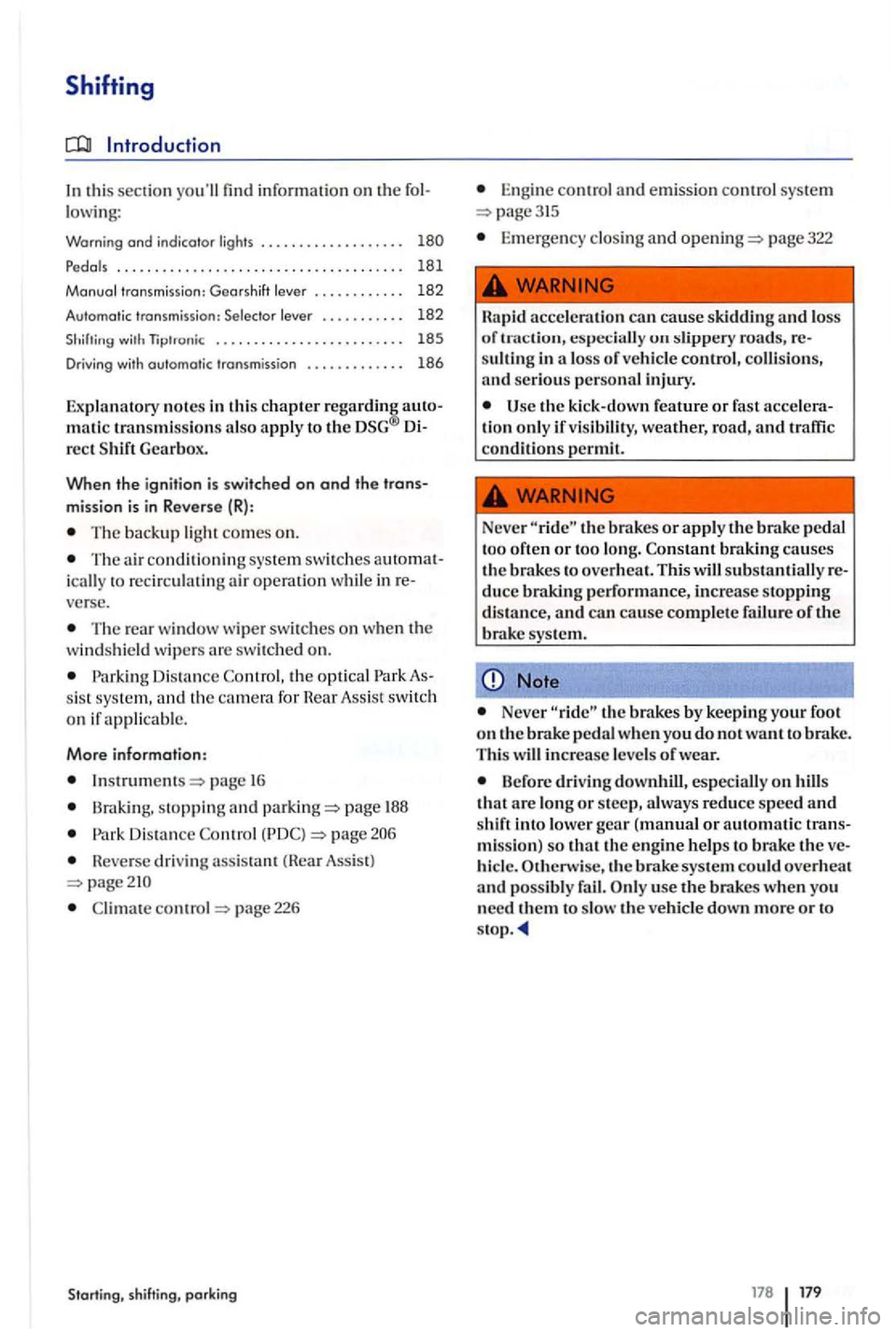
Shifting
Introduction
In this section you'll find information on
. . . . . . . .
Pedals . . . . . . . . . . . . . . . . . . . . . . . . . . . . . . . . . . . . . . 181
Manual transmi ssion: Gearshift lever . . . . . . . . . . . . 182
Automa tic transmission: Selector lever . . . . . . . . . . . 182
with Tiptronic . . . . . . . . . . . . . . . . . . . . . . . . . 185
Driving with automatic transmission . . . . . . . . . . . . . 186
E xplanatory no tes in thi s chapter also apply rect Gearbox.
When the ignition is switched on and th e
T he backup light comes on.
Th e air co nd itionin g sys te m sw itch es ically r ecirculat ing air verse.
The rear window wiper swi tches on when
sis t sys te m , a nd camera For
Instrum em s
Brak ing, and
D is tance
H everse driving assista nl (Rea r Assist)
Clima te comrol
Eng in e contro l and emission cont rol sys tem
Eme rgen cy closi ng and page 322
accelera tion can cause skidding and loss of t ract ion, especially on slipp ery roads, sulling in loss of vehicl e control , collision s,
and seriou s personal injury.
kick -d own feature or fast ti on onl y if vis ibility, weather, road , and traffi c
co nditi ons permit.
Neve r
or apply the p edal often or lo ng. Constant brakin g ca uses the brakes to over hea t. This subs ta nti ally duce performance, increase stop1> ing
d is tance, and cau se complete failure of th e
Note
Neve r the brakes by keeping your foot
o n brake ped al when you do not want to brake.
Thi s
Before driving downhill , es peci all y on that are lon g or steep, alw ays reduce speed an d into lower gear (manual or auto mati c mission) so that th e engin e help s to brake hi cle. Otherwi se, th e brake system could over hea t and possibl y fail. use th e when yo u
n eed them slow v ehicl e dow n more or
Page 189 of 541
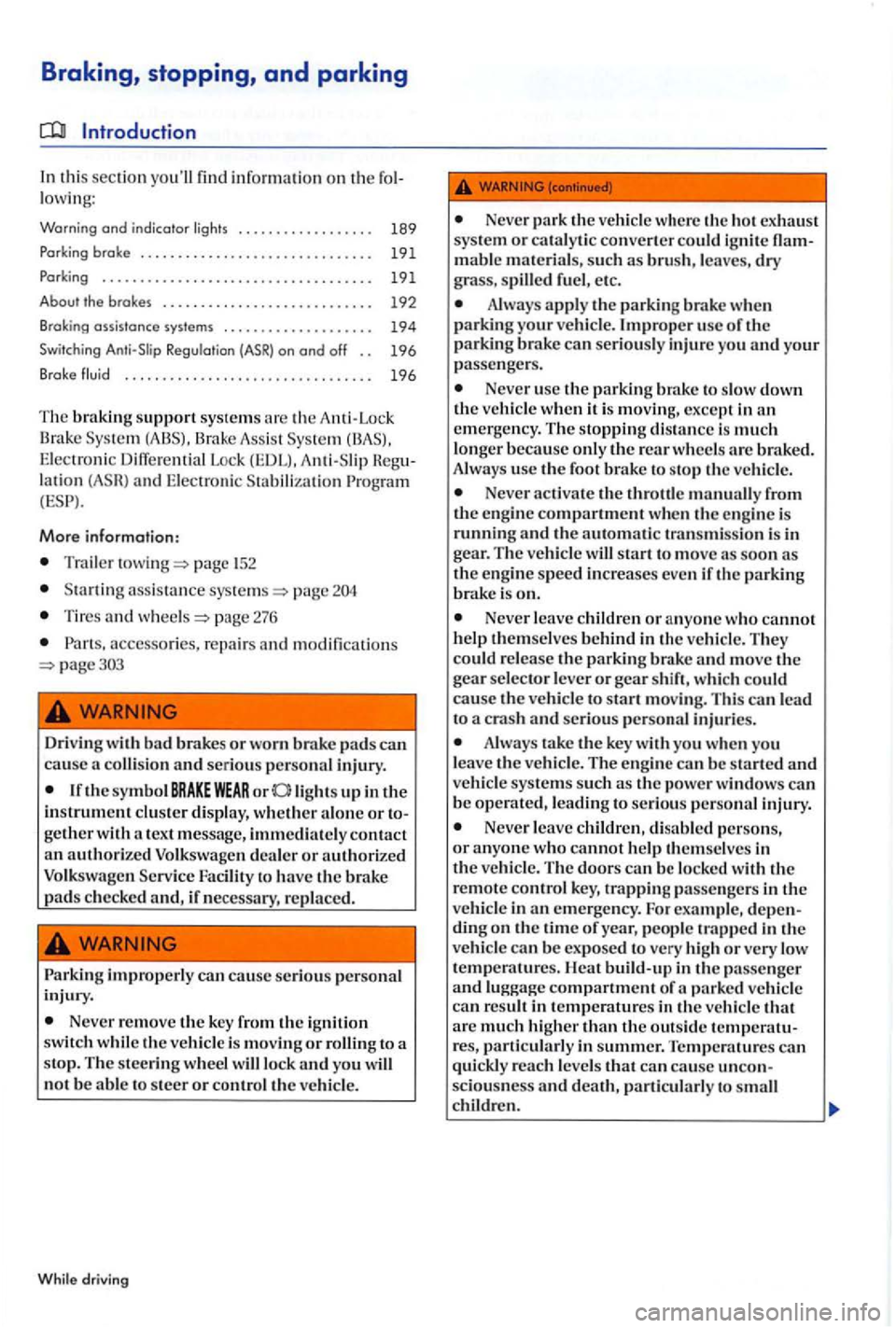
Braking, stopping, and parking
Introduction
In this section yo u'll find inform ation on fo l
lowi ng:
Warning and indicator lights . . . . . . . . . . . . . . . . . 189
Park in g brake . . . . . . . . . . . . . . . . . . . . . . . . . . . .
.. . . . . . . . . . . . . . . 19 1
About t
he brakes . . . . . . . . .. . . . . . . . . . . . .. . . . 192
Bra king assistance sys tem s . . . . . . . . . . . . . . . . . . . . 194
Switching Anti-Slip Regulation (ASR) on ond off . . 196
Brake fluid . . . . . . . . . . . . . . . . . . . . . . . . . . . . . . . . . 196
T he brakin g support syste ms are Brake A ss is t E lec tro nic Differ e n tial Loc k (EDL). Anti-Slip
M ore information:
Trail er page
pag e
Tires and page 276
acce ssories, r epa ir s and modifi catio ns
brakes or worn brake pads can
ca use colli sio n and serious personal inju ry.
light s up in the
in strument cluste r di splay, w heth er a lo n e or to
ge ther with tex t message, immediat ely conta ct an authorized Volk swage n dea ler or authorized
Volkswag en Se rvi ce Faci lity to have th e brake pad s ch ecke d and , if necessary, re pl aced.
WARNING
improperly can cause se riou s pe rso nal
injury .
Never re m ove key from the ignition switch while vehicl e is m ov ing or ro llin g to a
s top. The steering w heel w ill lock and you not be
Never park the vehicle w here the ho t ex ha ust
syste m or catalyti c convert er could ignit e flam
mabl e mater ia ls, su ch as brus h , leaves , dry grass, spilled fue l, e tc .
Always apply th e parki ng brake whe n
p a rki ng your veh icle. Imprope r u sc of th e
p a rking bra ke can se rio usly injur e you and your passe nge rs.
Never use the
e m ergency . The stopping dista n ce is muc h
longer b ec au se onl y the wheels arc braked . use the foot brake to sto p the vehicle .
Never the throttl e from
th e e ng in e
th e automati c transmission is in gear. The ve hicle will start t o move as soon the e ngine speed ev en i f th e brake is on.
Never leave childr en or anyo ne w ho canno t
h elp them se lve s beh in d in the vehicl e. They could re leas e the brak e move the gear selector leve r or shift , wh ic h could cause th e vehicle to start m ov ing. Thi s ca n lea d
to a cras h and seri ous personal injuri es.
Always take the key with you when yo u
leave th e ve hicle . The engine ca n be started and ve hicl e sys te m s s uch as the power wind ows can
b e operate d , le ad ing to seri ous perso nal injury.
Neve r leave childr en , di sabled perso ns, or a nyon e who cannot h elp them se lves in the vehicl e. T he doors can b e lo cke d wit h the re mote contro l ke y, trapping passe nge rs in the
ve hicle in an emerge ncy. For exa mpl e, dep ending on th e tim e of year, people trappe d in the
ve hicle can be ex pose d to very high or very temperatures. Heat build -up in the passenger and parked vehicl e result in temperatu res in the ve hicl e th at arc much hi gher than the outsid e tempe mtu
res, partic ul arl y in summer. T emperatures ca n
qui ckly reac h le v e ls that can cause uncon
scio usn ess ch ildr en.
Page 190 of 541
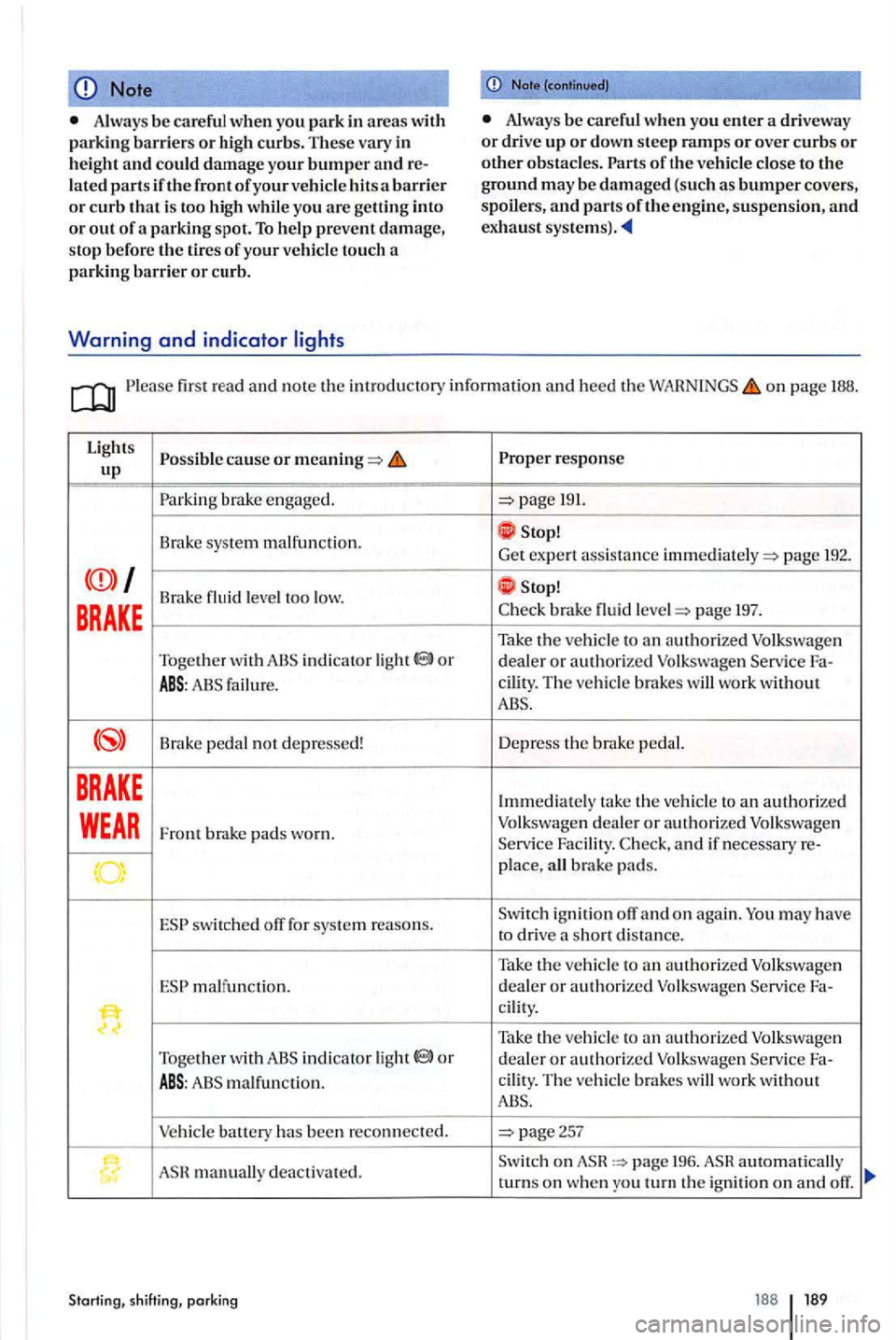
Note
Always be careful when you park in areas with parking barriers or high cmbs. These vary in h eigh t and could damage your bumper andrelated parts ifLhe front of your ve hicl e hit s a barrier or curb that is too high while you are getting into or out of a parking spot . To help prevent damage, stop before the tires of your vehicle touch a parking barrier or curb.
Warning and indicator
Note (continu ed)
Always be careful when you enter a driveway or drive up or down steep ramps or over curbs or obstacles. of the vehicle close to Lhe ground may be damaged (s u ch as bumper covers,
spoilers, and parts of the engine, suspen sion, and exhaust
firs t read and note Lhe introdu ctory informat io n and hee d the WAHNINGS page 188.
Lig ht s
191.
Brak e syste m malfun ction. Stop!
Get
expert assi stance pag e 192.
Brake fluid leve l too low. Stop!
BRAKE brake fluid page 197.
Take the vehicle to an au thorized indicator light or dea ler or authorize d Volksw agen Service Fa-
ABS: failure. ci
lity. Th e ve hicl e brakes will work without ABS.
Brake pedal not depressed! Depress the brake
pedal.
BRAKE Immediate ly take the vehicle to an auth orized
WEAR Front brake pads wo rn. Volkswagen dealer or authorized Volk swage n
Serv ice Facility. and if necessary re-place, all brake pads.
switc h ed off for syste m r easo ns. Switch ignit ion off an d on again . You may have
to dri ve a short dis tan ce.
Take th e ve hicle to an authori zed Volksw age n malfunc ti on. dealer or a
uthorize d Volk sw agen Service Fa-cilit y .
Tak e the vehicl e to or d ea le r or a uthori zed Volksw agen Service Fa-
ABS:
page257
manually deacti va te d. S
witch on p age 196. a ut om atically
turns on w he n you turn the ig nition on and off.
Startin g, shift ing, parking 188 189
Page 193 of 541
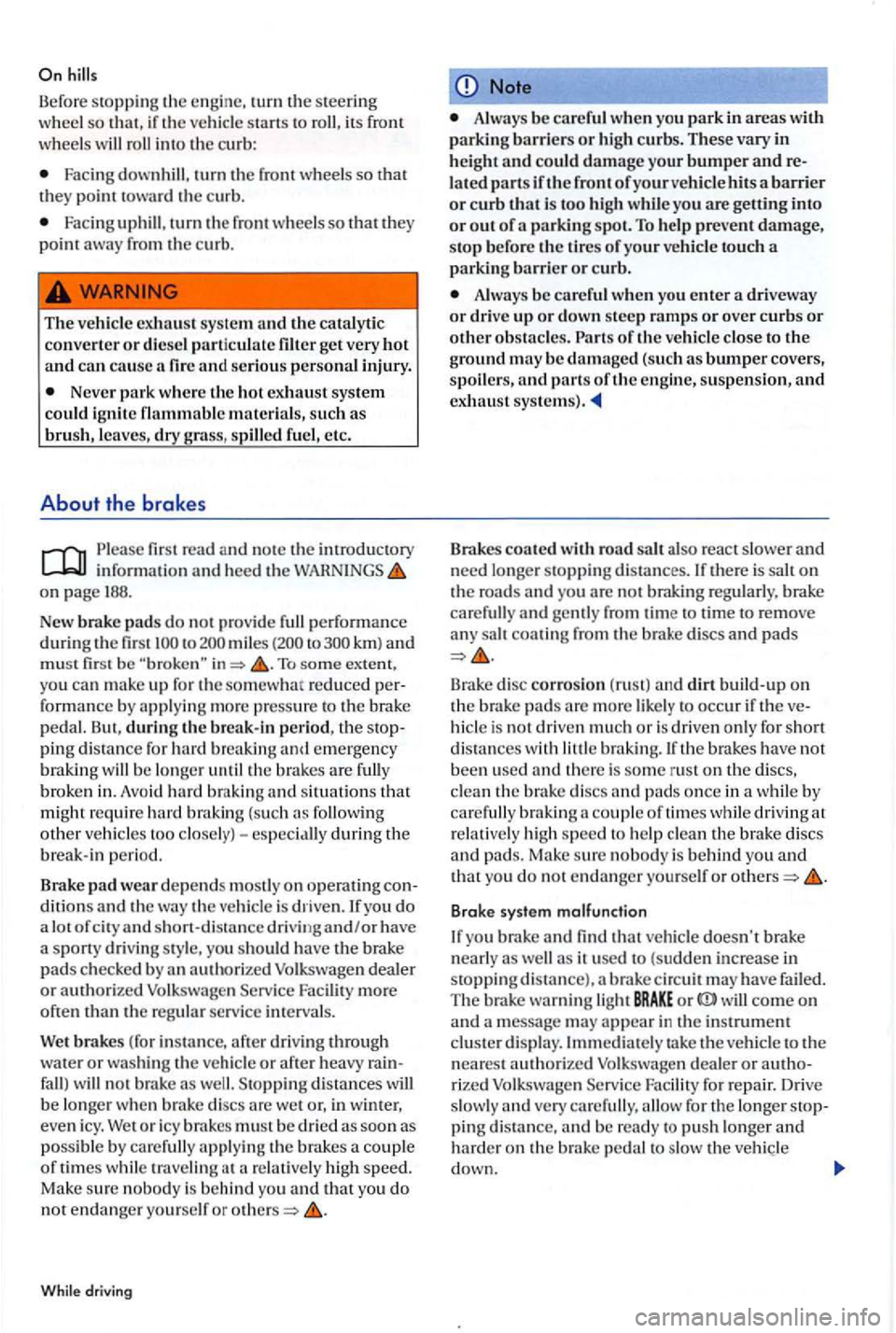
Befo re stopping th e en gine, turn the s teerin g
w heel so th at, if the ve hicl e sta rt s to its w heels w ill int o th e curb:
Fac ing turn the fro nt whee ls s o th a t
they point t oward the curb .
Fa c in g uphill , turn the front whee ls so that th ey
p o int away from the curb .
WARNING
The vehicl e exh aust system and the catalyt ic
co nverter or diesel particulate filter get very hot and can cause a and serious personal injury.
Never park where the ho t exhaust system could ignite flammable m aterial s, su ch as brush, leaves, dry grass , spilled fuel, etc.
About the brakes
read and note th e introductor y information and hee d th e on page 188.
New d o not provi de to miles to km) and m ust firs t be
hard braking and situ atio ns that
mi ght re quir e hard braking (such follow in g other vehicles too closely)-during the break-in period .
pad wear depe nd s m ostly o n operatin g the vehicle is d riven.lfyou do a l ot o f ci ty and shor t-dis ta nce driv ing and/or have
a sp o rt y driv in g s ty le, yo u sh ould have th e brake
p ad s checke d by a n authorized Vol ksw age n d eal er or a u thori ze d Volkswagen Service Fa cilit y m ore
o fte n than the regula r servi ce interva ls.
Wet
r e la tive ly hi gh speed.
Mak e sure nobo dy is be hind you and that yo u do
not endanger yo urself or
Not e
Alwa ys be careful when you park in areas with parking barriers or high curbs . T hese vary in heig ht and could damage your bumper lated parts if the front of your ve hicl e hits a barrier or curb that is too high while you are getting into or out of parking spot. To help prevent dam age,
s top b efore the tires of your ve hicle touch a parking barrier or c urb.
Alwa ys be c areful when you enter a or down steep ramps or over curbs or other obstacl es. o f th e v ehicl e close to the ground be damaged (such as btm1per covers,
s p oi lers, and parts of the en gine, suspension, and exhaust sys tems).
coa ted with road sa lt also react slowe r and need lo nge r stopping dis ta n ces. there is salt o n
t h e ro ads and you are no t b raki ng reg ularly , b ra ke carefully and ge ntl y from tim e to tim e to rem ove
a n y salt coa ting from the bra ke discs an d pad s
Brake d isc corro sion (rust) and dirt buil d-up on
th e br
ake pads are m ore like ly to o ccur if th e hide is no t dri ven muc h or i s drive n only fo r sh o rt dista nces w ith littl e brakin g. th e brake s have not
been use d and th ere is so me ru st o n t he di scs, clean th e brak e discs and p ad s o nce in a whi le by carefully braking co upl e of times whi le dri v in g at
r e lati vely hi gh sp ee d to help clean the bra ke di scs
and pad s. Mak e sure n o bod y is behind you and that you do no t enda nger yo urself or
B rake system malfunction
you brake and
th e ve hicl e to the n earest authorize d Volkswage n dea ler or
p in g d is ta nce, and be ready to pus h lo nger and harder on th e brak e pedal to slow th e ve hicl e
d own.
Page 194 of 541
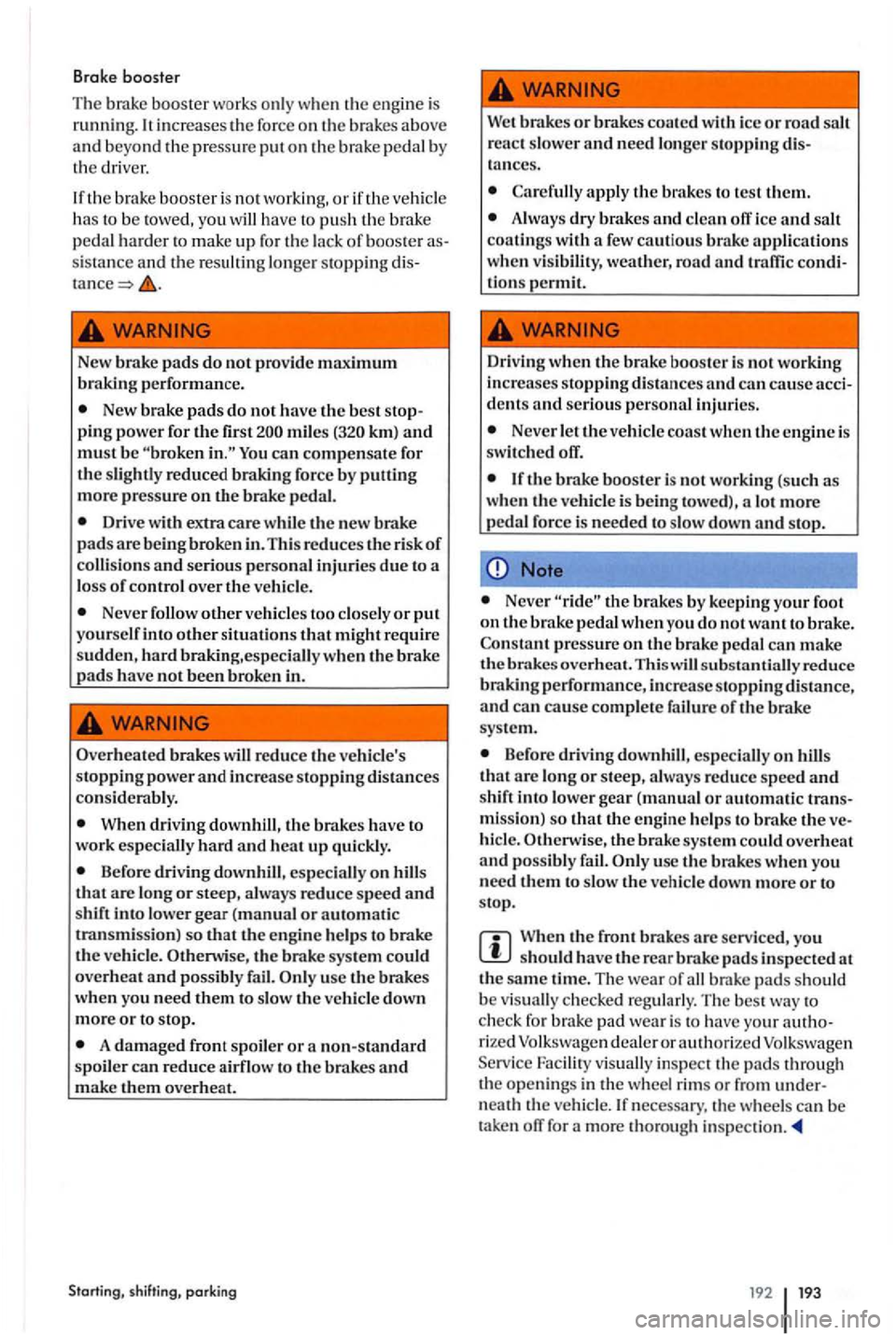
Brake booster
Th e brak e boo ste r w ork s o
nly wh en the engi ne is
running . It increa se s th e forc e on the brake s above and beyond the pre ssure put on th e brake pedal by
the driver.
If the brake booster is not working, or if th e ve hicl e
ha s to be towed, you have to push th e brak e
p ed a l hard er to make up for the lack of booster
New brake pads do not provide maximum braking performance.
New brake pads do not have the best ping power for the first km) and must be You can compensate for the slightl y reduced braking force by putting more pressure on the brake pedal.
Drive with
Never follow otl1er vehicles too closely or put yourself into other sit uation s that might require sudden, hard braking ,especially when the brake pads have not been broken
Overheated brakes
When driving downhill , the brakes have to
work es pecially hard and heat up quickly.
Before driving downhill, es peciall y on th at are long or steep, alwa ys reduce s peed and shift into lower gear (manual or automatic
transmission) so that the engine he lp s to brake
the vehicl e. Othenvise, the brake system cou ld
ov erheat and pos sibly u se the brakes
w hen yo u need them to slow the v ehicl e down
m ore or to stop.
A damaged front spoiler or a non- standard spoiler can reduce airflow to the brakes and
Starting, shifting, parking
Wet brakes or brakes witl1 icc or road salt
react slow er and n eed lo n ger stoppin g tances.
Ca refully apply the brakes to test th em.
Always dry brak es and clean off ice and salt
coat ings with a few cautious
tions permit.
Driving when the booster is no t working
in creases stopping distances and can cause dent s and seriou s personal injuries.
Never le t the vehicl e coast when the en gine is
switc hed off.
If the brake booster is not working (such as
w he n the vehicle is bein g towed), a lot more pedal force is needed to slow down and stop.
Note
Neve r the by keeping your foot on the to brak e.
Constant pressure on the brake pedal can make th e brakes overheat. This sub stantially reduce
braking performance, increase stopping di stan ce, and can cause co mpl ete failure of th e brake
s y stem.
Before driving downhill, especially on that are long or steep, always reduce speed and shift into lower gear (manua l or automati c
When th e front brake s are serviced , you should have the rea r brake pads inspected
rized Volksw agen deal er or au th orize d Volkswa gen
Service Facility vis uall y insp ec t th e pads through
th e o pe nin gs in the wh eel rim s or from nea th tl1e ve hicle. If n ecess ary, the wheels ca n be
t ake n off for a mor e thorou gh
192 193
Page 197 of 541
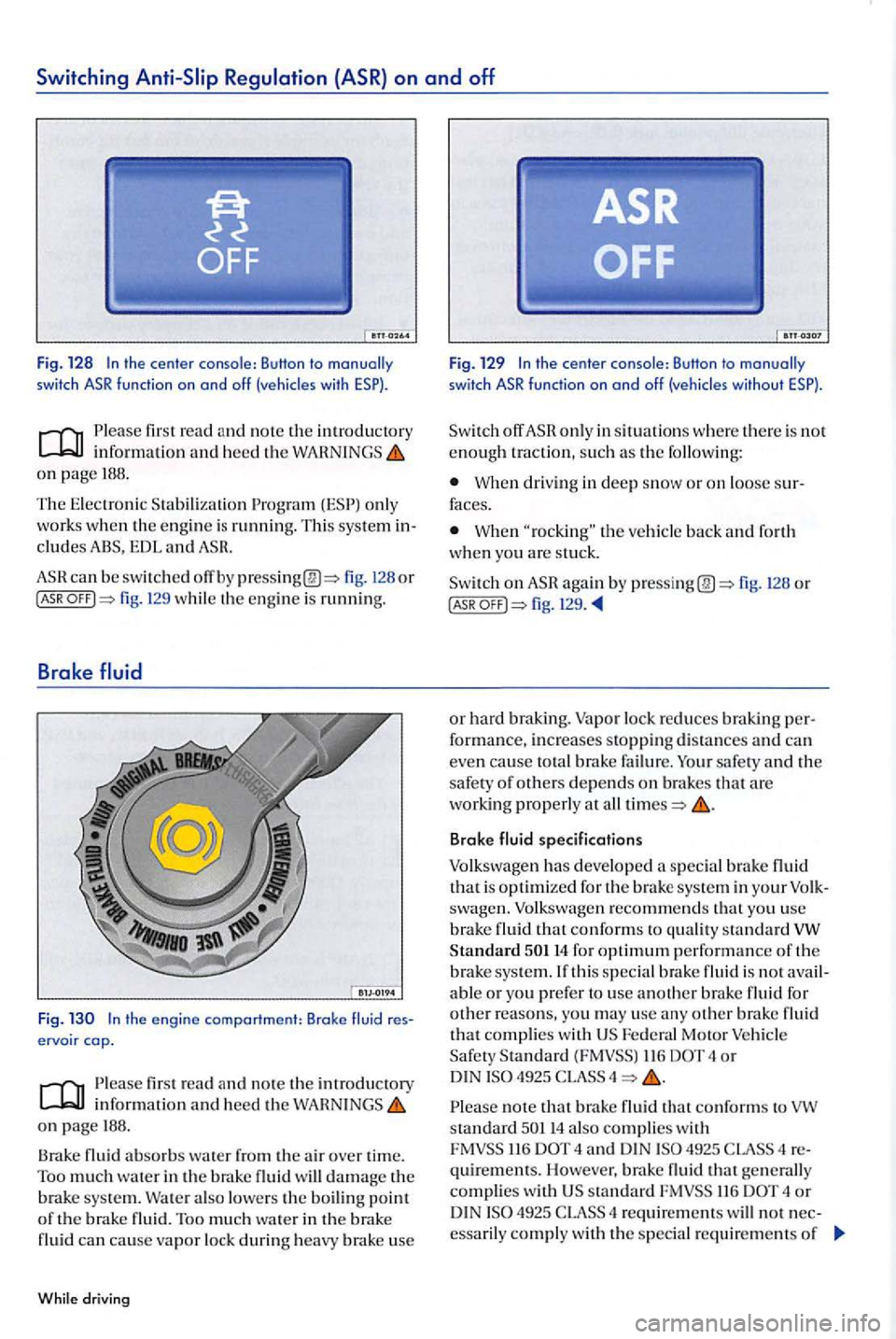
Switching
the center console: Button to with
Please fir st read and no te the introductory informatio n and heed the on page
The Electronic Stabili zation Program
cludes
can b e switched off by fig. (ASR fig. 129 whil e th e engi ne is running.
B rake
ervoir cop.
Please fir st r ead and note the introductory information and heed the on page 188.
Brake fluid
absorbs wate r from the air over time. Too much water in the brake fluid will damage the brake system. Wa te r a lso lowers th e boiling point o f the brake fluid. Too much wate r in the brake
fluid can cause vapor lock during heavy brake use
Whi le driving
Fig. 12 9 the center console: Button to switc h function on and without
off only in situations w here there is not enough traction, s u ch as the fo llo wing:
When driving in deep snow o r o n loose faces.
W hen
on again by fig. 128 or (ASR fig. 129 .
or hard braking. Vapo r lock reduces braking
safety and the safe ty of others d e pends o n brakes that are working properly at all
Brake
swagen. Volkswagen recommends that yo u use brake fluid that conforms to quality standard 14 for optimum p erformance of the brake system. If this s pecial brake fluid is not
Motor Vehicle 116 4 or 4
Please note that brake fluid that conforms to standard 14 a lso complies w ith 116 4 and DIN 4 quirements. However, brake fluid that generally complies with 116 4 or 4925 CLASS 4 requirements w ill not essarily comply with the s pecial requirements of
Page 204 of 541
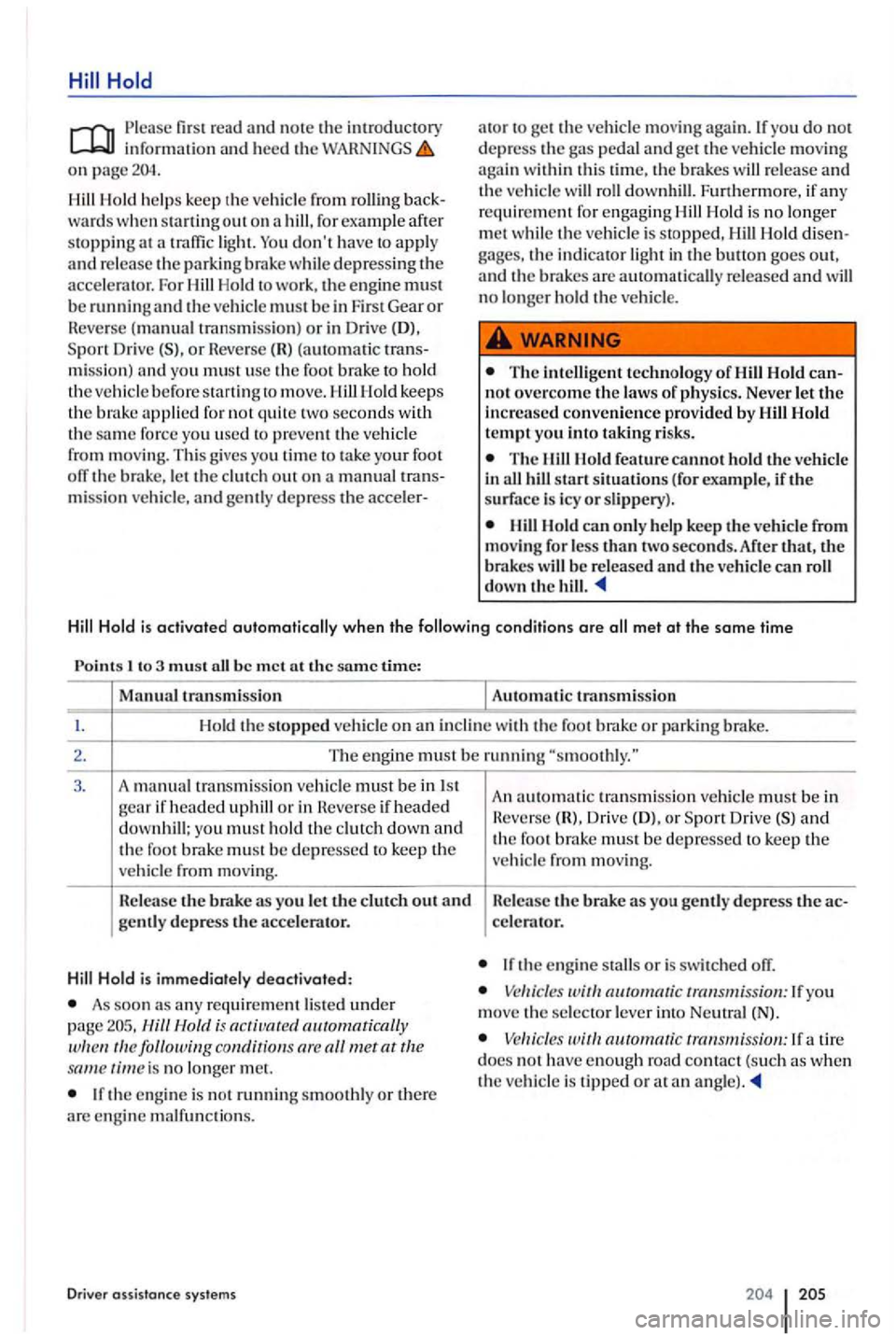
first r ead and n ote th e introducto ry in forma ti o n o n page
Hill Hold help s keep th e vehicl e from rollin g back
w ard s w hen sta rtin g out on a hill , for example aft er
s topping at a lig h l. don 't h ave to appl y
and r e le ase the parkin g brak e whi le dep re ss in g the For Hill Hold to work . th e e ng in e m ust
b e runni ng and the veh icle mus t b e in First Gea r or R eve rse (m anual tran smissio n) o r in Driv e (DJ. Dri ve (S), o r Reve rse (R) (a utomatic trans
mi ssion) and yo u must usc the foo t b ra ke to ho ld
th e ve hi cle befo re
force yo u u sed to pre ve nt the ve hicl e
from moving. This g ives you tim e to take your foo t
off the brake, le t t h e clu tc h out on a m anual t ran s
m ission ve hicle . and gently depress the acc ele r- a
to r to
p edal and ge t the ve hicl e moving
a ga in w ithin this time, the brake s will and the ve hicle will roll downhill. Furtherm ore , if re qu ire m en t f or e nga gin g Hill Hold is no lo nge r
m et while the vehicle is s toppe d, Hill Hold di sengages, the in dicator light in the butto n goes out,
a nd the brakes are automatically re leased and will no lo nge r h old the ve hicl e.
The intelligent technolo gy of
The llillllold feature cannot h old the ve hicl e
in all start situ ations ( for example, if the
surface is icy or s lip pery ).
Ho ld can only help keep the ve hicl e from mov ing fo r l ess than two seconds. Af te r tha t, the
b rakes be re lease d and the ve hicl e can roll
d ow n the hill .
Hill Hold is activated outomoli colly when the following conditions ore all met at the some tim e
I to 3 mus t b e m et a t the sa m e time:
M
anua l tran smissio n Automatic transmission
H old the stoppe d ve hicle on a n in cline w ith th e foot brake o r park in g brak e.
2.
3.
The e ngine must be run ning
if uphill o r in Revers e if headed
d o w nhill; you must hold th e clutch down and the foo t brak e must b e d ep ressed to keep th e
ve hicle from mo ving.
R elease the brake as yo u let the clutch out an d
g e ntl y de press the accelerator.
Hill Hold is imm ediat ely deactivated :
As soon an y re qu ire m en t liste d unde r page is a cti ua te d auto matically follo win g con d itio ns ar e time is no longe r m el.
If the engin e is not runnin g smoothl y or there
a rc e ng in e malfun ctions.
D river assista nce systems
A n autom atic transmissio n ve hicle must b e in
H e vc rse (R). Dr iv e (D ), or S po rt Drive ( S) and th e foot brak e m ust be d epresse d to keep the
ve hicle from movin g.
R el
ease the brake as yo u gentl y depress t11e celc rnt or.
If th e e ng in e s tall s or is swi t c he d off.
Vehicles ruitl1 automatic If you m ove the selector lever i nt o N eutral (N).
Vehicl es autom ati c tran smission: If a tir e docs no t h ave eno ug h ro ad contac t (s uch as w hen the ve hicle is tippe d or at an
Page 260 of 541
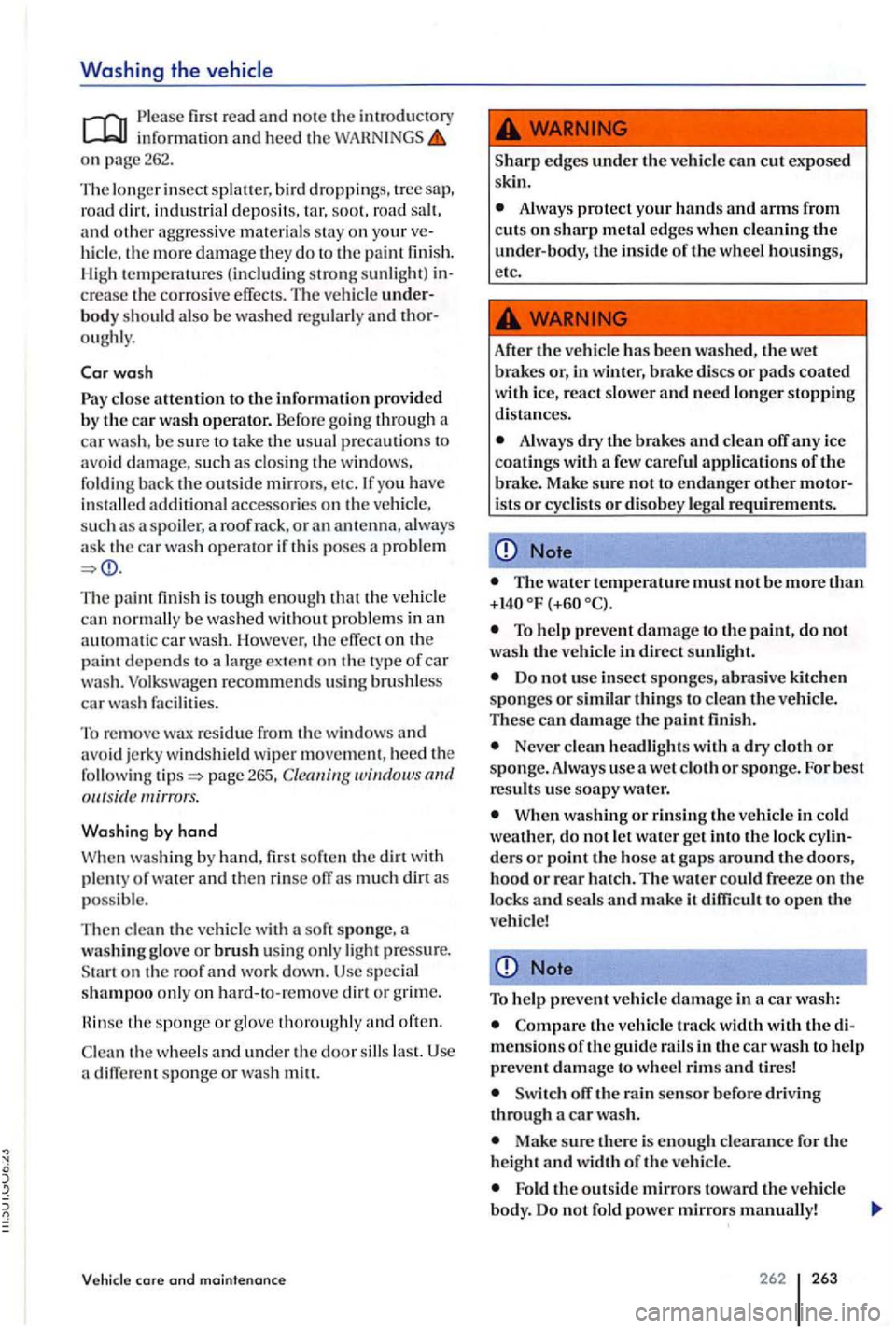
Washing the
fir st read and note th e in formatio n and heed th e on page 262.
The lo nge r insect splaue r, b ird droppings. tree sap,
road din, indu strial depo sits, road and o ther aggressive materials sta y on your ve
hicle , more damage they do sunlight ) crease the corros ive effects. The vehicle underbody sh o uld als o be was hed regularl y and thor
o ughly.
to the information by the car wash operator. Before going through a
ca r wash , b e s ure
you have installed addition al accessorie s on the vehicle, su ch as a spoiler, a roof rack, or an ant enna, alway s
a sk th e car was h opera tor if thi s po se s problem
The paint finish is
dep end s a la rge exte nt on th e rype of ca r
was h. Volk swagen recommend s using brush le ss
ca r w as h faciliti es.
' l b
rem ove wax res idu e from th e windows and
avoi d jerky wind shi eld wip er move m ent , heed the
f ollow ing page 265, outsi de
w ith
on the roof and work down. Usc sp ec ia l shampoo only on hard-to -remove or grim e.
Hinsc
different sponge or wash mill.
edges under the vehicle
Always protect your hands
Alway s dry the brakes and clean off any icc
coatings with a few caref ul appli cations oftlte brake. Make sure not to endanger other motoris ts or cyclists or disob ey lega l requirement s.
Note
The water temperature mus t not be more than
To help prevent damage to the paint, do not wash the vehicle in direct sunlight .
Do not use insect sponges, abrasive kitchen
s ponges or similar things to clean the ve hicle .
These can damage the paint finish.
Neve r clean headlight s with a dry cloth or sponge. Always use a
When washin g or rinsing the vehicle in cold
weather, do not let water get into the lock cylin ders or point the hose The water could freeze on the locks and seals and make it difficult to open the vehicle!
Note
To help prevent vehicle damage in a car wash:
the vehicle track width with the di
men sion s of the guide rail s in the car wash to help prevent damage to wheel rims tires!
off the rain sensor before driving
through a wash .
Mak e sure there is enough clearan ce for the height and width of the ve hicle.
Fold the outside mirrors toward the vehicle
body. Do not fold power mirrors manually!
262 263